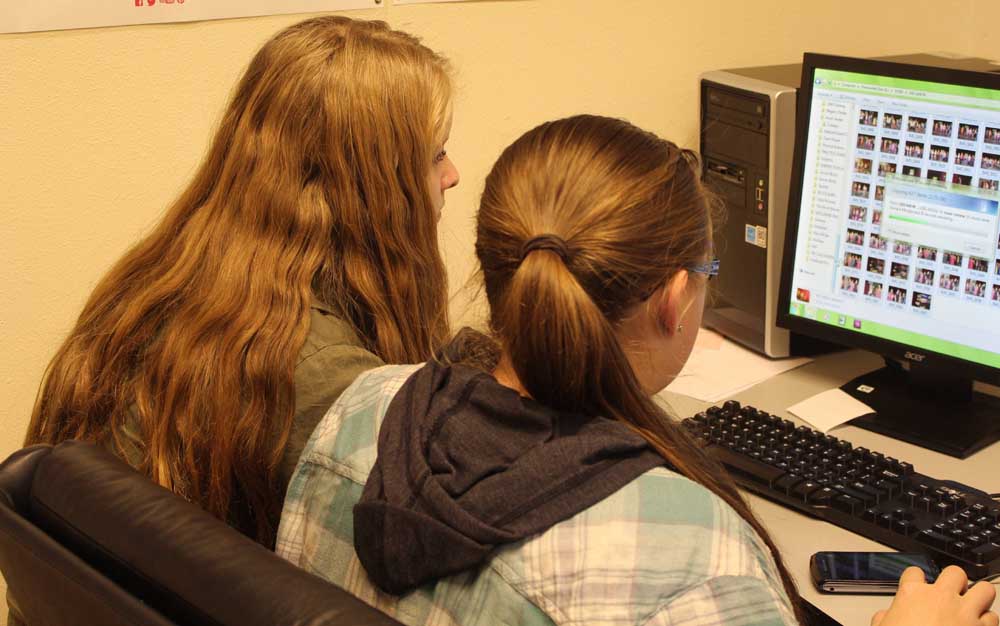Yearbook staff captures year in photographs for student body
Published 5:29 am Thursday, December 17, 2015

- Students in the yearbook class at Seaside High School look through photos for this school year's edition of the Seabreeze.
Students in the yearbook class have an important charge: capturing moments, both commonplace and extraordinary, throughout the school year to be preserved as memories in each annual edition of Seabreeze, Seaside High School’s longstanding yearbook.
The class, run by English teacher Susan Baertlein, runs yearlong, but not all students can take it each term, because of scheduling conflicts. Baertlein, who is in her third year teaching yearbook at Seaside High School, generally loses a few and gains a few as the year goes on.
Senior Silvia Avila, who started with yearbook as a freshman, said participating in the class “is basically like a job.” The students have fun in the class, but also must adhere to high standards of professionalism and work ethic to find advertisers and meet production deadlines.
“If you don’t do your responsibilities, other people have to pick up the slack,” said Avila, one of the editors-in-chief. “You have to be here every day and do your best.”
Advertisements help drive the price of the product down from $85 to $35 from students. Because the students rarely hear get turned down by individuals and businesses for advertising, they don’t have a negative view of soliciting sponsorship, Baertlein said.
“We have really good community support,” she said.
Normally students do a little of everything for the yearbook, but this year, Baertlein designated students as photographers and designers, although they still might get called on to help where and when needed.
The photographers attend events throughout the school year, from plays and assemblies to athletic games. If they’re smart, Baertlein said, the students will seek out people like local photographer Jeff Ter Har to get tips. Otherwise, the students learn fast through experimentation, she said.
Yearbook teaches several transferable skills that can be used now for other classes and will be remain valuable in the future. Some of those skills, according to students, include professional communication, verbal and written communication and using software for publication design. Avila said the skills she learned helped her get an internship at State Farm insurance during the summer.
Tenth-grader Danielle Keen, a designer, has used the knowledge learned from the class to do projects for other classes and also privately for herself. Meanwhile, she’s working to write more for the yearbook and improve her photography skills.
The yearbook class has several officers: two editors-in-chief, a photo editor, a business manager, a social media administrator and two ambassadors of fun.
Photo editor Megan McQuilliams, a 10th-grader, was encouraged to join yearbook by her sister, who enjoyed the class. As photo editor, she is responsible for collecting, organizing and editing photos from the other staff members and making selections for the yearbook.
Students must find creative ways to share highlights from each school year. The team keeps the theme a secret, to make the yearbook’s unveiling “a bigger deal,” Baertlein said. However, while “a yearbook is full of secrets,” she promised this year’s layout will be “drastically different.”
To help the students learn more about the publishing industry and generate new ideas for the upcoming year, Baertlein takes a few students — those who show leadership in the class — to a three-day camp, provided by Herff Jones, at Willamette University in the summer. During the camp, students from across the northwest attend workshops and listen to a guest speaker who shares fresh ideas and strategies for making innovative yearbooks and avoiding clichés.
Students said sometimes it is tough to have their ideas rejected or critiqued at the camp, but it drives improvement.
“Striving to be better is a big thing with yearbook camp,” Baertlein said.
McQuilliams agreed the camp exposed the students to new ideas.
“My mind is more open to possibilities now,” she said.
The design for the yearbook is getting better, Baertlein said. They are mixing content and using creative strategies. Since Baertlein took over the class, Avila said, the students have been given more involvement and responsibility.
“This year, we have more say in what we want in the actual book,” she said.
The book is generally about 200 pages, with a supplemental annex of about 24 pages. The final layout for the yearbook is sent to a printer in Utah, Herff Jones, by spring break; then students put together the supplement, with graduation the finishing touch, before printing it locally right after the commencement ceremony to be delivered as a single produt during the traditional all-night senior party. The yearbook distribution caps off the party, as students take time looking through and signing the books with one another.





